Iron is the world's most widely utilized metal, serving as a critical component in industries such as construction, engineering, automotive, and machinery, mainly through its role in steel production. Consequently, the availability of iron ore is a vital element in the global economic landscape. In 2023, according to Statista, the top producers of iron ore were Australia and Brazil, with Australia generating approximately 960 million metric tons and Brazil contributing around 440 million metric tons of iron ore. The top three iron ore-producing countries (Australia, Brazil and China) accounted for 63% of global production.
The Carajás Mine, located in the Carajás Mountains of northern Brazil, is recognized as the world's largest iron ore mine. Situated in the municipality of Parauapebas, within the state of Pará, it operates as an open-pit excavation. The mine boasts an impressive reserve, estimated to contain around 7.2 billion metric tonnes of iron ore.
In this article, we discuss different types of iron ore, the best choice of grabs for the different types of iron ore and (un)loading conditions to keep in mind. Everything you need to know to boost your iron ore loading and unloading productivity.
Major countries in iron ore mine production worldwide in 2023
(in million metric tons)
Table of contents
1. Iron ore has mainly three different types2. Loading and unloading conditions to consider
3. The best choice of grabs for different types of iron ore
4. The best grab for pelletized iron ore
5. The best grab for iron ore concentrate
6. The best grab for iron ore fines
7. Diversity of iron ore varieties
8. Comparable substances to iron ore
9. Maximizing efficiency and durability in iron ore handling with the NemaX grab
10. Are you curious about which grab is the best option for your iron ore unloading situation?
Iron ore has mainly three different types:
1. Pelletized iron ore
2. Iron ore concentrate: this is an output product from processed iron ores that have been milled (crush, grind, magnetic separation, flotation) to separate deleterious elements and produce a high-quality product.
3. Iron ore fines
A notable phenomenon of iron ore
A notable phenomenon is the compaction of iron ore while it’s being shipped. This compaction is significant enough to alter the density of the material, affecting both its volume and weight by the time it reaches its destination.
For example, when iron ore is loaded onto a ship for transport, it possesses a certain density level, measured at approximately 2.4 tons per cubic meter. However, as the iron ore is being transported, it undergoes a natural compaction process. The constant movement of the ship, combined with the pressure exerted by the weight of the ore itself, gradually compresses the material. By the time the ship arrives at its destination, the iron ore can become significantly more compacted, with its density increasing to about 3.1 tons per cubic meter at the bottom of the ship.
Loading and unloading conditions to consider
Choosing the correct grab for the specific type of iron ore is essential for terminal operators to ensure optimal terminal efficiency and prevent overloading. The choice for the ideal grab also requires a good understanding of the prevailing conditions:
- Unloading with shore-based cranes or floating transshipment
- Size of the ship: barge or ocean-going vessel (OGZ)?
- Type of crane:
Due to the high speeds of a gantry crane, the faster opening and closing of the NemaX and the Scissors grab become even more important. Therefore these two grabs are the most suitable for a gantry crane. For mobile cranes, the NemaX and Clamshell are the best options.
The primary challenge of unloading iron ore involves identifying the optimal grab solution and unloading procedure to maximize productivity. It's also crucial to evaluate how the type of grab impacts the costs related to supplementary equipment, such as trimming tools and personnel, along with the maintenance costs tied to these operations.
The best choice of grabs for different types of iron ore
For optimal handling of iron ore loads below 35 tons, the clamshell and NemaX grabs stand out as the most effective and efficient choices. Particularly for handling weights below 30 tons, the clamshell grab stands out as the most practical option.
Conversely, when dealing with capacities that surpass 35 tons, both the Scissors Grab and NemaX significantly outperform in terms of productivity. Generally speaking, for loads starting from 25 tons and upwards, the NemaX emerges as the best option, offering unmatched performance and suitability for a wide range of iron ore handling requirements.
Each grab type presents unique advantages tailored to specific operational needs:
- NemaX Grab: Known for its lightweight and fast opening and closing speed, it outmatches the clamshell grab in these aspects, enabling it to handle more tons per cycle and more cycles per hour. This efficiency makes it the most productive choice for iron ore handling.
- Clamshell Grab: The clamshell grab is a very productive grab for a wide variety of your bulk materials. Especially for loads lighter than 30 tons. It can be made more environmentally friendly by enclosing the shells.
- Scissors Grab: Above a safe working load of 35 tons, it’s well known for its durability and suitability for dense or compact materials, because of its heavy weight, which results in better penetration. The Scissors grab has a high average productivity thanks to its fast opening and closing mechanism and short cycle times. It also performs excellently on sloping surfaces, reducing your need for trimming equipment and staff.
In short, the appropriate grab selection depends on the type of crane, its safe working load, the bulk material characteristics, and the type of operation. Each grab type offers distinct advantages in terms of weight handling, speed, and operational efficiency.
The best grab for pelletized iron ore
The best choice to unload pelletized iron ore is a lightweight clamshell or a NemaX grab.
For operations involving pelletized iron ore, the NemaX is the preferred option, as it offers:
- at least 10% better efficiency than lightweight clamshell grabs;
- energy cost reductions of at least 10% for every ton of material processed, significantly impacting ROI positively beyond just the productivity gains;
- lowest maintenance costs;
- long life span of the closing ropes.
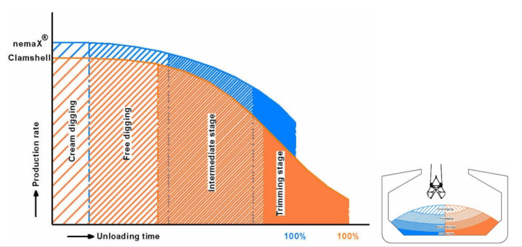
Watch this video where our client Vale Brasil chose a clamshell grab for the unloading of Tubarao; a special kind of iron ore.
The best grab for iron ore concentrate
For unloading iron ore concentrate, the Scissors grab or NemaX are the best option.
The compaction of this material is higher than normal or pelletized iron ore. Therefore, the horizontal digging pattern allows the grab to maintain a higher average volume. With the vertical digging pattern of the clamshell the filling degree will reduce when handling compacted material. Therefore the Scissors grab or NemaX will be the best option in this case.
Watch this video where iron ore is being unloaded from a ship to a hopper at Vale Oman with the Nemag scissors grab.
The best grab for iron ore fines
For iron ore fines, both Scissors grab, clamshell grab, and NemaX are suitable.
Diversity of iron ore varieties
Iron ore is not a one-size-fits-all resource; its characteristics vary widely depending on its source, which significantly impacts its suitability for different industrial processes. Several types of iron ore stand out for their specific properties and moisture content (mc), a crucial factor in handling and shipping these materials:
1. Vale IOCJ Brazilian high Fe Ore fines 5%mc
2. Vale SSFT Brazilian iron ore fines 5%mc
3. RTZ Carol lake Canadian iron ore concentrates 0.9%mc
4. Australian Rocket lump 6.1%mc
5. LKAB KPBA Swedish iron ore pellet 3.0%mc
6. Swedish iron ore pellet chippings 1.4%mc
7. Vale IOCJ Brazilian high Fe Ore fines 10%
8. Vale SSFT Brazilian iron ore fines 8%mc
9. RTZ Carol lake Canadian iron ore concentrates 10%mc
10. Vale IOCJ Brazilian high Fe Ore fines 8%
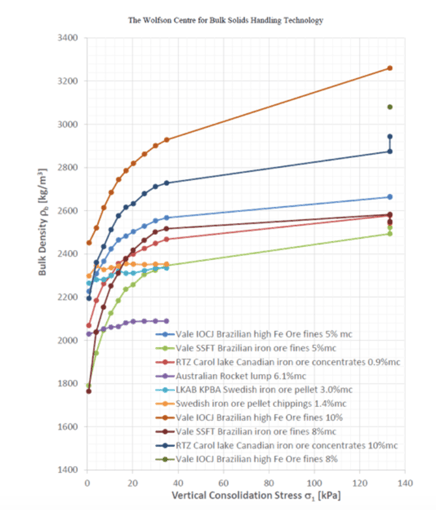
Bulk density versus Vertical Consolidation stress for different types of iron ore.
Source: The Wolfson Centre for Bulk Solids Handling Technology
Comparable substances to iron ore
In the world of metal resources, some materials are similar to iron ore and can be used in different ways. These alternatives have special qualities that suit certain industrial needs.
- Direct Reduced Iron (DRI): Direct Reduced Iron stands out as a prime alternative. It's produced through the direct reduction of iron ore and is highly sought after for its purity in steelmaking processes. It serves as an efficient, low-impurity intermediary that steel producers highly value for its metallurgical properties.
- Hot Briquetted Iron (HBI): Hot Briquetted Iron, a derivative of DRI, is another notable substitute. By compressing DRI at a high temperature, HBI is created as a dense, compact form of DRI, convenient for handling, shipping, and storage. Its resistance to reoxidation and uniform size makes it a popular choice in electric arc furnace steelmaking.
- Tubarao: Tubarao, often distinguished by its granular consistency, is a specialized form of iron ore. Harvested from specific regions, it possesses unique metallurgical characteristics that make it a valuable resource for producing high-quality steel, where the consistency of the raw material is crucial.
- Chrome ore: Chrome ore emerges as a counterpart, primarily in the production of stainless steel and various alloys. Although not a direct substitute, its role in alloying renders it an integral component in crafting materials with desirable characteristics such as corrosion resistance, hardness, and aesthetic appeal.
Maximizing efficiency and durability in iron ore handling with the NemaX grab
When it comes to handling iron ore, whether it's pelletized iron ore, iron ore concentrate, or iron ore fines, the NemaX grab stands out as a superior choice. Its unique design and construction, created with the help of the TU Delft, provide a multitude of advantages that not only enhance operational efficiency but also significantly reduce long-term costs and maintenance requirements.
The NemaX grab's design, which features fewer parts, reduces wear and tear over time. This design ensures that maintenance needs are minimized, setting a new industry standard for low maintenance costs. Furthermore, the grab's impressive productivity, exceeding that of comparable clamshell grabs by more than 10%, translates into faster unloading times and increased throughput for terminal operations. This grab has especially a good digging performance in coarse materials.
The use of high-tensile, wear-resistant steel in the construction of the NemaX, along with an excellent bearing system, underlines its durability and long service life. These materials ensure that the grab can withstand the harsh conditions and abrasive nature of iron ore handling, all while maintaining a relatively low dead weight. This balance between strength and weight contributes to the grab's high productive capacities, making it an ideal tool for the efficient and cost-effective handling of iron ore and similar materials.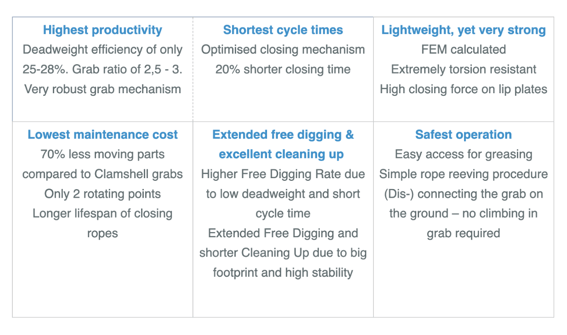
USP's NemaX
Watch this video where one of our clients picks up a NemaX grab to handle chrome ore.
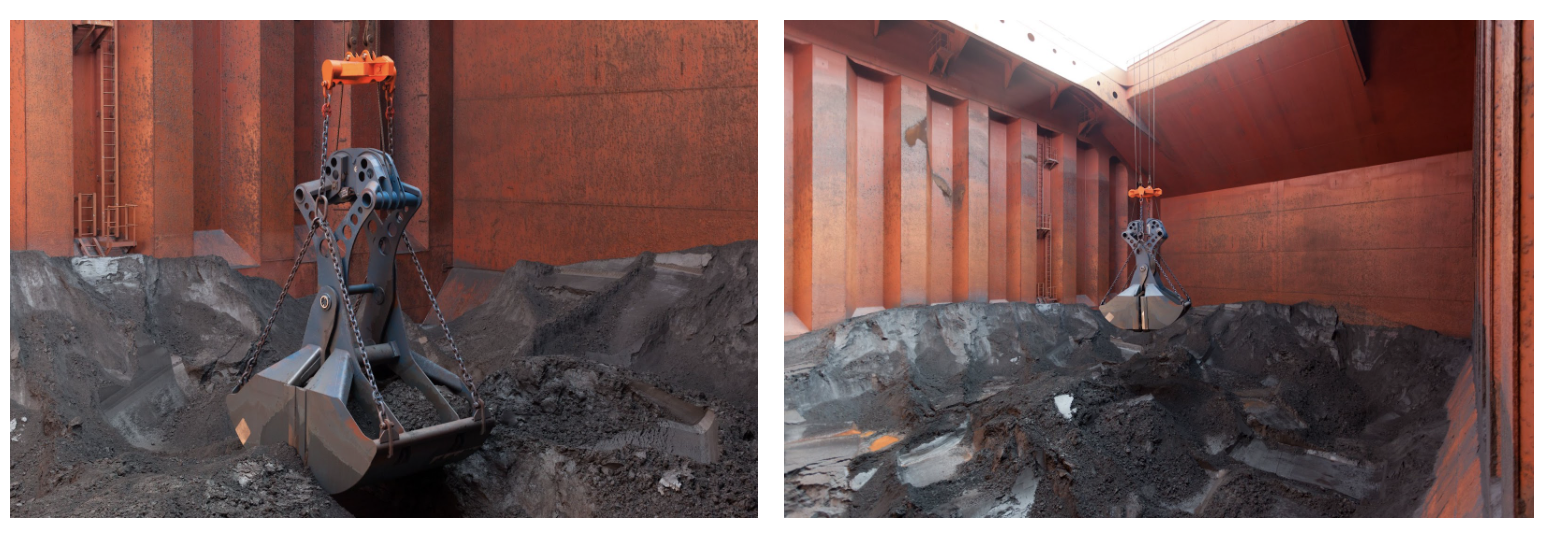
Are you curious about which grab is the best option for your iron ore unloading situation?
At Nemag, we only manufacture custom dry bulk grabs. Accordingly, we have the expertise to optimize the grab’s productivity based on your type of iron ore, crane and other factors. For instance, SMT Shipping increased its productivity by 25% with the NemaX grab. Discover their story here.
Alternatively, you can read the Letter of Recommendation from Jonas Chupe, Head of Procurement at Voestalpine Texas Group. In their iron ore operation, Nemag increased their standard crane load capacity of 50 MT by 5-6 MT and reduced the average unloading cycle time from 82 to 60 seconds.
Feel free to contact us, book a meeting to receive a free consultative call to find the best grab type for your application to boost your loading and unloading productivity.

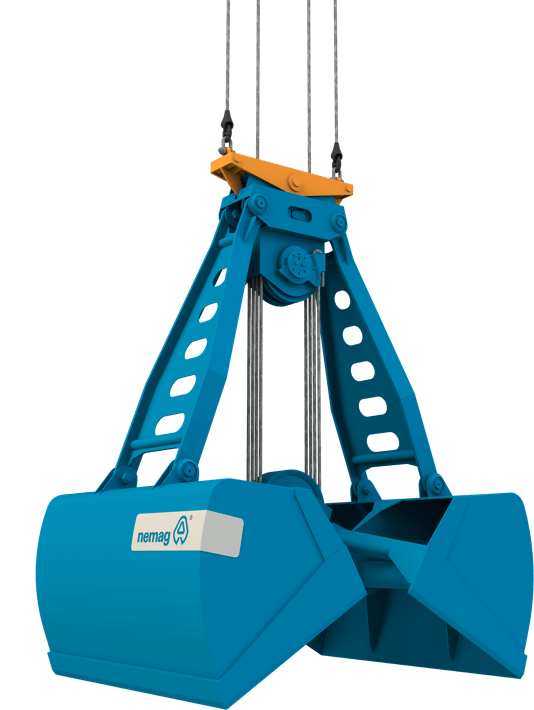
.png?width=535&height=333&name=Major%20countries%20in%20iron%20ore%20mine%20production%20worldwide%20in%202023%20(in%20million%20metric%20tons).png)


